More thoughts about buildings and food
In "Gentrifying neighborhood puts chill on meatpacker," the Chicago Tribune reports about how remnants of the meatpacking industry and district still exist in Chicago, and how one family, the Chiapoettis, is thinking of selling out, because of the value of their 2 acres of land, which they use for lamb slaughtering. From the article:
Part of an industry that symbolized the brawn and economic might of blue-collar Chicago, Chiappetti's now is out of place in its neighborhood, where two-legged animals are willing to spend $500,000 for a house. The area, west of U.S. Cellular Field, is up and coming for residential development because it's near to downtown but still a relative bargain.
Five years ago, a developer could buy a lot south of 39th Street, or Pershing Road, for $20,000; today they sell for $150,000. North of 39th Street, lots sell for as much as $300,000.In the middle of it all sits Chiappetti's, whose operations in antiquated buildings at separate complexes at 38th and Halsted Streets and 39th and Emerald spread over two acres.
In the hearing a couple weeks ago, Terry Williams, a professor at CUA's architecture school and a former NYC economic development official who had a hand in creating the South Street Seaport back when the Fulton Fish Market was still there, testified saying that bringing housing to the Florida Market isn't necessarily a bad idea. He said that there is a segment of the market of people that want the grit. OTOH, I testified that it could create a built in lobby against "noise, smell, etc." associated with these kinds of activities.
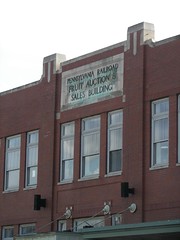
In Pittsburgh, the old Market Terminal has spun off on nearby Penn Avenue some amazing ethnic grocery stores
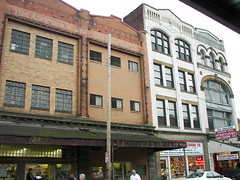
Pennsylvania Macaroni blows Litteri's away (I'm sorry to say this). It's huge, the size of a small grocery store (at least 15,000 s.f.), but it's next to an almost as amazing Greek grocery store (Stamoolis), two doors down from a biscotti bakery, across the street from a coffee roastery and shop, down the street from an amazing seafood grocery store-- the company also does wholesale and has an upscale separate cookware store, bakeries, more coffee shops and restaurants, and a butcher, a couple Asian groceries, a Mexican grocery, a produce stand, well, you get the picture. (Unfortunately, I didn't, my battery ran out on my camera, but I'll go back later in the week).
Collectively, these places, to my way of thinking, offer more than Philadelphia's Italian Market.
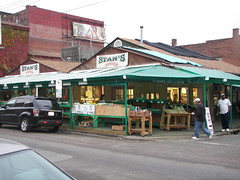
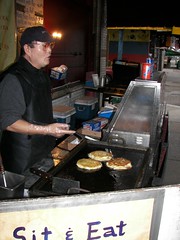 Two places, an Asian market and a Middle Eastern market, prepared some food on the street for sale to passersby, although they also prepared food for sale inside. Some of the groceries had sit-in areas for eating.
Two places, an Asian market and a Middle Eastern market, prepared some food on the street for sale to passersby, although they also prepared food for sale inside. Some of the groceries had sit-in areas for eating.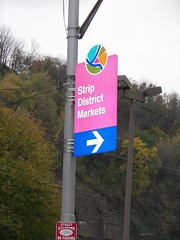
The Neighbors in the Strip organization, which is a Main Street program for the neighborhood (which has about 300 residents and is mostly a business-commercial-nightlife area), is working to recreate the Market Terminal into a public market hall. And there are separate plans for housing, probably, in the parcel between the market hall and the river. Plus, there is the conversion of the adjacent Armstrong Cork Factory into housing. (We toured that too. Pretty amazing.)
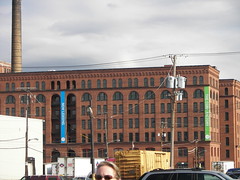 The Armstrong Cork Factory will have around 300 units of housing and is about one mile from downtown.
The Armstrong Cork Factory will have around 300 units of housing and is about one mile from downtown.An interesting point from the NITS presentation, that the City of Pittsburgh had pretty much left the Strip District to its own devices. Few services, not even including trash cans, have been provided. And this is in an area now with a lot of consumer patronage, especially at night, when the nightclubs are open.
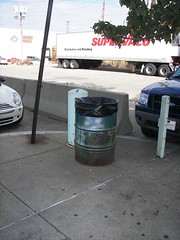 A steel drum makes due as a trash can near the Society for Contemporary Craft at one end of the market building.
A steel drum makes due as a trash can near the Society for Contemporary Craft at one end of the market building.Still, both the Chiappettis' story and Pittsburgh are relevant to considerations of DC's Florida Market. When you don't have extant buildings to convert to housing, the pressure is to tear stuff down to be able to build housing. And if you don't have much of an appreciation for the character and authenticity of places, then proposals to build a suburban condo complex in the city with "everything they have in Gallery Place including a bowling alley" sounds pretty good.
So what if you wreck what's already there to do this. After all, isn't America all about building new?
Of course, DC is a city, an urban place, and it's urban character should be protected and extended, not sanitized and destroyed.
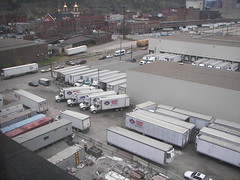 Pittsburgh's Strip District, photographed from the Armstrong Cork Building. The old market terminal is in the upper right.
Pittsburgh's Strip District, photographed from the Armstrong Cork Building. The old market terminal is in the upper right.Index Keywords: food-agriculture-markets



1 Comments:
Thank you for providing such a valuable information and thanks for sharing this matter.to get Online pharmacy from online medicine store.
Post a Comment
<< Home